Chinese Cubans are Cubans of full or mixed Chinese ancestry who were born in or have immigrated to Cuba. They are part of the ethnic Chinese diaspora.

Ronald Toshiyuki Takaki was an American academic, historian, ethnographer and author. Born in pre-statehood Hawaii, Takaki studied at the College of Wooster and completed his doctorate in American history at the University of California, Berkeley.
Interracial marriage is a marriage involving spouses who belong to different races or racialized ethnicities.
Kaniakapūpū, known formerly as Luakaha, is the ruins of the former summer palace of King Kamehameha III and Queen Kalama on the island of Oahu in Hawaii. Built in the 1840s, and situated in the cool uplands of the Nuʻuanu Valley, it served as the king and queen's summer retreat after the capital of the Kingdom of Hawaii moved from Lahaina to Honolulu in 1845. It was famous for being the site of a grand luau attended by an estimated ten thousand guests during the 1847 Hawaiian Sovereignty Restoration Day celebration. The palace had fallen into ruins by 1874; no records exist about its condition in the intervening years. Rediscovered in the 1950s, the site was cleared and efforts were made to stabilize the ruins from further damage by the elements and invasive plant growth. The site remains officially off-limits to the public and trespassers are subjected to citations, although the site is not regularly monitored.
The Africans in Hawaii, also known as Pōpolo in the Native Hawaiian language, are a minority of 4.0% of the population including those partially Black, and 2.3% are of African American, Afro-Caribbean, or African descent alone. The Black population is mostly concentrated in the Greater Honolulu area, especially near military installations. There is also a sizeable Cape Verdean American population, and there are some Hispanic people of African descent, namely Puerto Ricans.
Most early Asian settlers to the United States went to Hawaii. Most of these early immigrants moved to the islands as laborers to work on the pineapple, coconut, and sugarcane plantations. These early migrants have tended to stay, although a handful returned to their home countries. There has also been recent immigration to Hawaii from more ethnic Asian groups, including the Thai, Indian, Indonesian, and the Vietnamese.
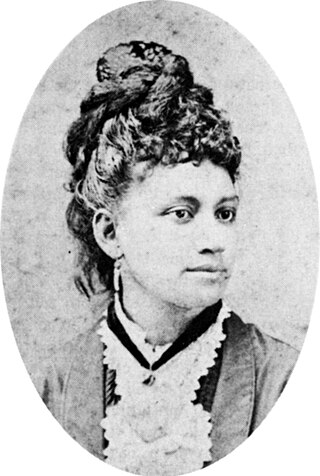
Elizabeth Sumner Chapman Achuck Lapana Keawepoʻoole was a Hawaiian high chiefess during the Hawaiian Kingdom and lady-in-waiting of Princess Likelike. An accomplished Hawaiian composer, she composed the popular Hawaiian love song Sanoe with Queen Liliʻuokalani, which was about a love affair in the Hawaiian royal court in the 1870s.
After the outbreak of the American Civil War, the Kingdom of Hawaii under King Kamehameha IV declared its neutrality on August 26, 1861. However, many Native Hawaiians and Hawaii-born Americans, abroad and in the islands, enlisted in the military regiments of various states in the Union and the Confederacy.
Hakka Americans, also called American Hakka, are Han people in the United States of Hakka origin, mostly from present-day Guangdong, Fujian, and Taiwan. Many Hakka Americans have connections to Hakka diaspora in Jamaica, the Caribbean, South East Asia, Latin America, and South America. The Han characters for Hakka (客家) literally mean "guest families". Unlike other Han ethnic groups, the Hakkas are not named after a geographical region, e.g. a province, county or city. The Hakkas usually identify with people who speak the Hakka language or share at least some Hakka ancestry. The earliest Hakka immigrants to what is now the United States mostly went to Hawaii, starting when the Kingdom of Hawaii was an independent sovereign state. After the lifting of the Chinese Exclusion Act by the passage of the Magnuson Act in 1943, the Hakka began to come to the US from Taiwan and to a lesser extent Hong Kong, Southeast Asia, Jamaica and the Caribbean.
George Naʻea, was a high chief of the Kingdom of Hawaii, and father of Queen Emma of Hawaii. He became one of the first Native Hawaiians to contract leprosy and the disease became known as maʻi aliʻi in the Hawaiian language because of this association.

George Charles Beckley was an English captain, trader, and military adviser. He was one of the earliest foreigners to have a major impact in the Kingdom of Hawaii, where he eventually became a noble, and was one of the disputed creators of the Flag of Hawaii.

Emma ʻAʻima Aʻii Nāwahī was a Native Hawaiian political activist, community leader and newspaper publisher. She and her husband Joseph Nāwahī were leaders in the opposition to the overthrow of the Kingdom of Hawaiʻi and they co-founded Ke Aloha Aina, a Hawaiian language newspaper, which served as an important voice in the resistance to the annexation of Hawaiʻi to the United States. After annexation, she helped establish the Democratic Party of Hawaiʻi and became a supporter of the women's suffrage movement.
Tong Kee, also known as T. Aki, was a Chinese immigrant and businessman who settled in the Kingdom of Hawaii. In 1886–87, he was embroiled in the Aki opium scandal,, a bribery corruption scandal involving King Kalākaua and Junius Kaʻae reneging on a bribe Aki made to secure the sale of an opium license.

Chun Afong was a Chinese businessman and philanthropist who settled in the Hawaiian Kingdom during the 19th century and built a business empire in Hawaii, Macau and Hong Kong. He immigrated to Hawaii from Guangdong in 1849 and adopted the surname Afong after the diminutive form of his Cantonese given name, Ah Fong.

Kalākaua was the last king and penultimate monarch of the Kingdom of Hawaiʻi. The inherited position of the kingdom's monarch became a legislatively elected office with Lunalilo. Upon Lunalilo's death, Kalākaua won election over his political opponent Queen Emma. He reigned from February 12, 1874, until his death in San Francisco, California, on January 20, 1891.

Julia Hope Kamakia Paaikamokalani o Kinau Beckley Fayerweather Afong was a Hawaiian high chiefess who married Chinese millionaire merchant Chun Afong with whom she had sixteen children. She was of British, American and Hawaiian descent.
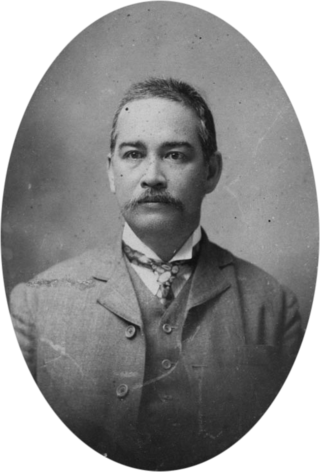
Chun Chik-yu ; June 12, 1859 – October 18, 1936) was a Chinese-Hawaiian businessman who served briefly as Governor of Guangdong Province from 1922 to 1923. He was born Toney Afong, full name Antone Abram Kekapala Keawemauhili Afong.

Chun Lung was a Chinese businessman in the Hawaiian Kingdom. He sometimes used his father's Hawaiianized surname and was known as C. L. Afong. He was also known as Alung or Ah Lung using the common Cantonese diminutive prefix Ah before his given name.
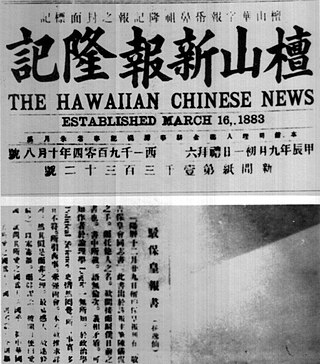
The Hawaiian Chinese News, also known as New Honolulu Journal, Tan Shan Hsin Pao, Lung Kee Sun Bo, was a Chinese language commercial newspaper in Honolulu, USA. It was founded by Cheng Weinan in 1881, initially called the Lung Chi Pao (隆記報), renamed Tan Shan Hsin Pao (檀山新報) in 1903.
Tin-Yuke Char was a Chinese-American historian and businessman who was interested in the history of the Hakka people and Chinese people in Hawaiʻi.













